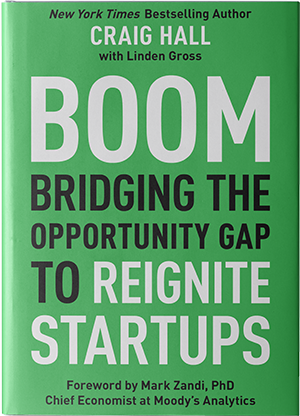Ironically, entrepreneurship has never been more popular in the U.S. Just look at Shark Tank and its six million weekly viewers. While “the Fab Four” were the kings of popular culture in the ’60s and ’70s, we now look up to Bill Gates, Steve Jobs, Jef Bezos, and Mark Zuckerberg. Not only are they the subjects of books and films, but they are inspiring a whole generation of kids to be entrepreneurs just like them.
Entrepreneurship has become contagious. A 2014 study by Babson College and Baruch College found that optimism about becoming an entrepreneur in this country had reached its highest level in more than fifteen years, with more than 50 percent of the adult population believing that good opportunities exist for starting a business.
And yet, paradoxically, we are living in one of the hardest times to be an entrepreneur, which is defined by Webster’s Dictionary as “a person who starts a business and is willing to risk loss in order to make money.” U.S. entrepreneurship has largely been on the decline for more than three decades, spanning five presidencies. Despite an amazing amount of positive energy in the nonprofit sector and the groundswell of university programs geared toward entrepreneurship, only half as many businesses start up annually as they did a generation ago. Data from the Census Bureau’s Business Dynamics Statistics (BDS) reveals that in 2015, the nation’s 414,000 startup firms generated 2.5 million new jobs. Contrast those numbers to the pre–Great Recession level of startup activity. From 2002 to 2006, an average of 524,000 startup firms and 3.3 million new jobs per year were created. According to the Ewing Marion Kaufman Foundation, “New economic research demonstrates that the entrepreneurship deficit is tied to stagnant productivity, job loss, inequality, and growth, which means lower wages and living standards for Americans.”
A shocking lack of available capital across much of the U.S. is partly to blame, especially when you consider the fact that the vast majority of the capital is concentrated in just a few locations—Silicon Valley, New York, and Boston—and in a single sector. While there is plenty of capital for technology startups, traditional startups are not getting adequate access to capital. But, as we’ll see, that’s just part of the problem.
Not only have business startups (defined here as companies less than five years old) been declining for the better part of four decades but the situation is even worse for women and people of color.
In looking at U.S. entrepreneurship through the lens of my fifty years of entrepreneurial experience, I realize that the system today is stacked against startups and small businesses. Our playing field is not as fair or level as it has been historically. As a result, national entrepreneurship is declining in terms of the numbers of new businesses. For people like me who have already grown their companies, having less competition is a selfish advantage. But it hurts the country at large in many ways.
Ironically, entrepreneurship in the 1960s and early 1970s was not nearly as popular as it is today, but it was a given. There were simply more opportunities, and it was much easier to start a new business. Even though I had no relevant skills or background and very little money, I never questioned whether I could start a business. I simply knew it was my right as an American.
Television shows, movies, books, newspaper and magazine stories, advertising campaigns, and oral legends all teach American children that they can succeed at anything if they work hard and earn that success. But as my book, BOOM: Bridging the Opportunity Gap to Reignite Startups, will show, taking the risk and making a viable living as an entrepreneur has increasingly moved out of reach for many.
These days, most entrepreneurs’ and small-business owners’ success is hampered by too many roadblocks. To me, entrepreneurial success means taking an idea—or taking on a project—and creating a viable and profitable business that improves people’s lives. But starting a business requires a willingness to take a risk, which is challenging for many of us. It also requires startup capital, which for many these days is in short supply.
Money has become very scarce for all but big high-tech deals or other grand slams, making it almost impossible for entrepreneurs or small businesses to get loans or equity from traditional investing or lending sources. Once they clear that hurdle, they have to deal with mushrooming regulations, increasing bureaucracy, and a cost-prohibitive legal system in which startups can get smashed before they ever get going. Moreover, in my observation, many industries have experienced massive consolidation, which contributes to a more difficult environment for smaller companies. Then there’s the colossal economic power in the hands of the tech giants, and the resulting efficiencies and disruptions derived from the internet and the digitization of data. Add to all of this the dramatic geographic factors that we’ll explore in Chapter 1, and we can clearly see how two different worlds exist for entrepreneurs in the U.S. today.
In short, we have created a huge opportunity gap for many aspiring entrepreneurs who are not in technology or part of the country’s booming ecosystems.
The freedom to start and grow a business is one of the fundamentals of the American psyche and the American dream. The American dream means different things to different people. To some, it means owning their own home. To others, it means starting a business. To most of us, the American dream is about a personal sense of hope, liberty, and happiness, and the freedom to be whomever and whatever we want to be if we work to earn it. That’s always been the promise inherent in entrepreneurship. That promise, however, has been under attack for some time, and aside from some noteworthy exceptions in a small number of urban markets—or with many technologies or biotech-related business startups—that attack is accelerating.
This is a big issue, one that’s critical to America’s future. Entrepreneurship is the engine that drives job creation, tax revenue, quality of life, and innovation. And if the futurists are right, it’s poised to be an even bigger issue in the next decade or two, as globalization and technology make more and more jobs obsolete and displace more and more people from what we have historically known as work.
This is not a problem for just would-be entrepreneurs and small businesses. We can no longer afford to turn a blind eye to the decline of U.S. entrepreneurship. We need to challenge that status quo and begin to implement short- and long-term solutions, and we need to do it now.
Excerpted from BOOM: Bridging the Opportunity Gap to Reignite Startups. Copyright © 2019 by Craig Hall. Published by Savio Republic.
 Bridging the Opportunity Gap to Reignite Startups
Bridging the Opportunity Gap to Reignite Startups
There is an alarming decades-long decline of new business startups facing the United States today. BOOM exposes the reasons behind this downward spiral and outlines strategies to solve the problem.

